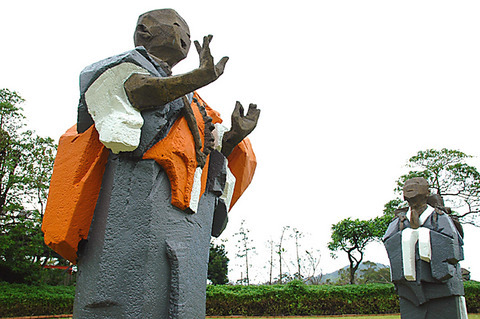Ju Ming (朱銘) is well known for his sculptures, created in bronze, clay and wood, but some people may have overlooked the fact that he is a painter too.
From the beginning of this month, the Juming Museum is presenting many of Ju's newest works in the Living World Series-Monk exhibition. It offers a rare opportunity for the public to take a peek at the mind of this grand master of art.
Ju sketches monks by using charcoal pencil or ink, occasionally coloring them lightly, and applies his technique in collage works to put a different twist on traditional ink paintings.

PHOTO COURTESY OF JUMING MUSEUM
Ju also adopts the collage technique, working with yellow and orange crepe paper to create a simple elegance with geometrical shapes. By combining different art mediums and using Chinese and Western techniques, Ju's New Ink Painting was born.
"Art is cultivation and without cultivation, the flowers from the hearts can never blossom," Ju answered when asked about the source of his vitality. What Ju means is that cultivation does not refer to some abstruse Buddhist philosophy, but daily comprehension of hows and whys and taking the effort to carry it out.
Born in 1938 in a small Miaoli County town, Ju gained international fame and then dedicated 12 years of his life to build Juming Museum, by investing almost all of his money in 11 hectares of land in Chinsan (金山), Taipei County. In 1999 this legendary gallery was founded. The museum "is home to an integral collection of Ju's work throughout his career," said Calvin Ju (
At 15, Ju was trained for three years in traditional temple wood-carving. In 1968, he was under renowned sculptor and modernist Yuyu Yang's (
In 1976, Ju's "raw yet refined treatment," as Calvin Ju describes it, of his wood sculptures won him great fame after an exhibition held at the National Museum of History in Taipei.
According to Lai Shen-chon (賴賢宗), Chinese Language and Literature professor of the National Taipei University, Ju's artistic creations can be divided into three stages: First, his "Nativist Series" is represented by his well-loved sculptures of water buffalos and historical figures such as Guan Gong (
Third, his favorite "Living World Series" explores the many facets of modern life, including his recent inclusion of over 300 bronze statues of war heroes.
"Monk" is the newest art form added to the Living World Series and touches upon self-cultivation. It is, perhaps, the artist's intention to pose the timely question of inner peace, at a time when society is deeply divided.

This month the government ordered a one-year block of Xiaohongshu (小紅書) or Rednote, a Chinese social media platform with more than 3 million users in Taiwan. The government pointed to widespread fraud activity on the platform, along with cybersecurity failures. Officials said that they had reached out to the company and asked it to change. However, they received no response. The pro-China parties, the Chinese Nationalist Party (KMT) and Taiwan People’s Party (TPP), immediately swung into action, denouncing the ban as an attack on free speech. This “free speech” claim was then echoed by the People’s Republic of China (PRC),

Exceptions to the rule are sometimes revealing. For a brief few years, there was an emerging ideological split between the Democratic Progressive Party (DPP) and Chinese Nationalist Party (KMT) that appeared to be pushing the DPP in a direction that would be considered more liberal, and the KMT more conservative. In the previous column, “The KMT-DPP’s bureaucrat-led developmental state” (Dec. 11, page 12), we examined how Taiwan’s democratic system developed, and how both the two main parties largely accepted a similar consensus on how Taiwan should be run domestically and did not split along the left-right lines more familiar in

Specialty sandwiches loaded with the contents of an entire charcuterie board, overflowing with sauces, creams and all manner of creative add-ons, is perhaps one of the biggest global food trends of this year. From London to New York, lines form down the block for mortadella, burrata, pistachio and more stuffed between slices of fresh sourdough, rye or focaccia. To try the trend in Taipei, Munchies Mafia is for sure the spot — could this be the best sandwich in town? Carlos from Spain and Sergio from Mexico opened this spot just seven months ago. The two met working in the

Many people in Taiwan first learned about universal basic income (UBI) — the idea that the government should provide regular, no-strings-attached payments to each citizen — in 2019. While seeking the Democratic nomination for the 2020 US presidential election, Andrew Yang, a politician of Taiwanese descent, said that, if elected, he’d institute a UBI of US$1,000 per month to “get the economic boot off of people’s throats, allowing them to lift their heads up, breathe, and get excited for the future.” His campaign petered out, but the concept of UBI hasn’t gone away. Throughout the industrialized world, there are fears that